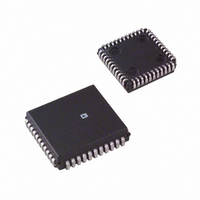AD7891APZ-1 Analog Devices Inc, AD7891APZ-1 Datasheet - Page 18

AD7891APZ-1
Manufacturer Part Number
AD7891APZ-1
Description
IC DAS 12BIT 8CH 44-PLCC
Manufacturer
Analog Devices Inc
Type
Data Acquisition System (DAS)r
Datasheet
1.AD7891BSZ-2.pdf
(20 pages)
Specifications of AD7891APZ-1
Resolution (bits)
12 b
Data Interface
Serial, Parallel
Sampling Rate (per Second)
500k
Voltage Supply Source
Single Supply
Voltage - Supply
5V
Operating Temperature
-40°C ~ 85°C
Mounting Type
Surface Mount
Package / Case
44-PLCC
Sampling Rate
500kSPS
Input Channel Type
Single Ended
Supply Voltage Range - Analog
4.75V To 5.25V
Supply Current
20mA
Lead Free Status / RoHS Status
Lead free / RoHS Compliant
Available stocks
Company
Part Number
Manufacturer
Quantity
Price
Company:
Part Number:
AD7891APZ-1
Manufacturer:
Analog Devices Inc
Quantity:
10 000
Part Number:
AD7891APZ-1
Manufacturer:
ADI/亚德诺
Quantity:
20 000
Company:
Part Number:
AD7891APZ-1REEL
Manufacturer:
Analog Devices Inc
Quantity:
10 000
AD7891
AD7891 PERFORMANCE
Linearity
The linearity of the AD7891 is primarily determined by the
on-chip 12-bit DAC. This is a segmented DAC that is laser
trimmed for 12-bit integral linearity and differential linearity.
Typical INL for the AD7891 is ± 0.25 LSB while typical DNL
is ± 0.5 LSB.
Noise
In an ADC, noise exhibits itself as code uncertainty in dc appli-
cations and as the noise floor (in an FFT for example) in ac
applications. In a sampling ADC, such as the AD7891, all
information about the analog input appears in the baseband from
dc to half the sampling frequency. The input bandwidth of the
track/hold amplifier exceeds the Nyquist bandwidth and,
therefore, an antialiasing filter should be used to remove
unwanted signals above f
where such signals exist.
Figure 17 shows a histogram plot for 16384 conversions of a dc
input signal using the AD7891-1. The analog input was set at
the center of a code transition in the following way. An initial dc
input level was selected and a number of conversions were
made. The resulting histogram was noted and the applied level
was adjusted so that only two codes were generated with an
equal number of occurrences. This indicated that the transition
point between the two codes had been found. The voltage level
at which this occurred was recorded. The other edge of one of
these two codes was then found in a similar manner. The dc
level for the center of code could then be calculated as the
average of the two transition levels. The AD7891-1 inputs
were configured for the ± 5 V input range and the data was read
from the part in parallel mode after conversion. Similar results
have been found with the AD7891-1 on the ± 10 V range and on
all input ranges of the AD7891-2. The same performance is
achieved in serial mode, again with the data read from the
AD7891-1 after conversion. All the codes, except for 3, appear
in one output bin, indicating excellent noise performance from
the ADC.
Figure 17. Typical Histogram Plot (AD7891-1)
18000
16000
14000
12000
10000
8000
6000
4000
2000
0
1 CODE
2148
S
/2 in the input signal in applications
OUTPUT CODE
16381 CODES
2149
2 CODES
2150
–18–
Dynamic Performance
The AD7891 contains an on-chip track/hold amplifier, allowing
the part to sample input signals of up to 250 kHz on any of its
input channels. Many of the AD7891’s applications require it to
sequence through low frequency input signals across its eight
channels. There may be some applications, however, for which
the dynamic performance of the converter on signals of up to
250 kHz input frequency is of interest. It is recommended for
these wider bandwidth signals that the hardware conversion
start method of sampling is used.
These applications require information on the spectral content
of the input signal. Signal-to-(noise + distortion), total
harmonic distortion, peak harmonic or spurious tone, and
intermodulation distortion are all specified. Figure 18 shows a
typical FFT plot of a 10 kHz, ± 10 V input after being digitized
by the AD7891-1 operating at 500 kHz, with the input connected
for ± 10 V operation. The signal-to-(noise + distortion) ratio is
72.2 dB and the total harmonic distortion is –87 dB. Figure 19
shows a typical FFT plot of a 100 kHz, 0 V to 5 V input after
being digitized by the AD7891-2 operating at 500 kHz, with the
input connected for 0 V to 5 V operation. The signal-to-(noise +
distortion) ratio is 71.17 dB and the total harmonic distortion
is –82.3 dB. It should be noted that reading from the part
during conversion does have a significant impact on dynamic
performance. Therefore, for sampling applications, it is
recommended not to read during conversion.
–120
–150
–120
–150
–30
–60
–90
–30
–60
–90
0
0
Figure 18. Typical AD7891-1 FFT Plot
Figure 19. Typical AD7891-2 FFT Plot
2048 POINT FFT
2048 POINT FFT
SNR = 72.2dB
SNR = 71.17dB
F
F
S
S
/2
/2
REV. D














